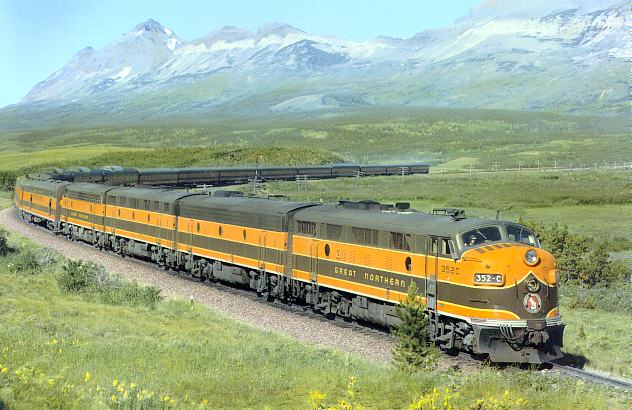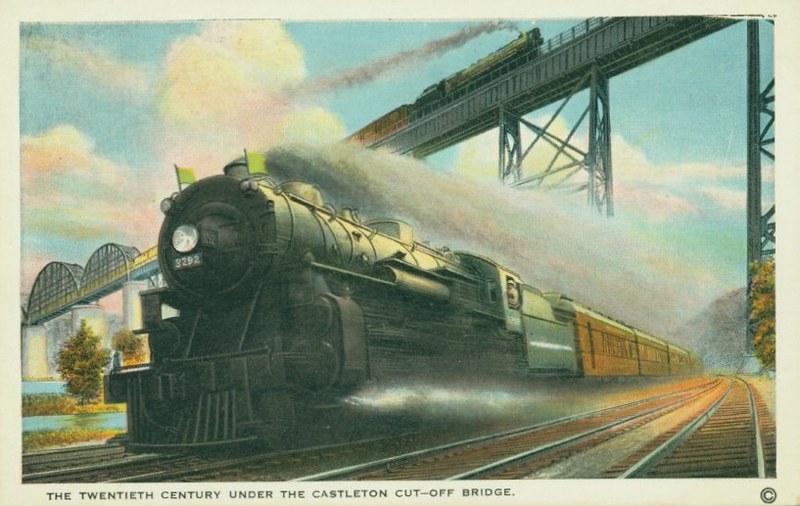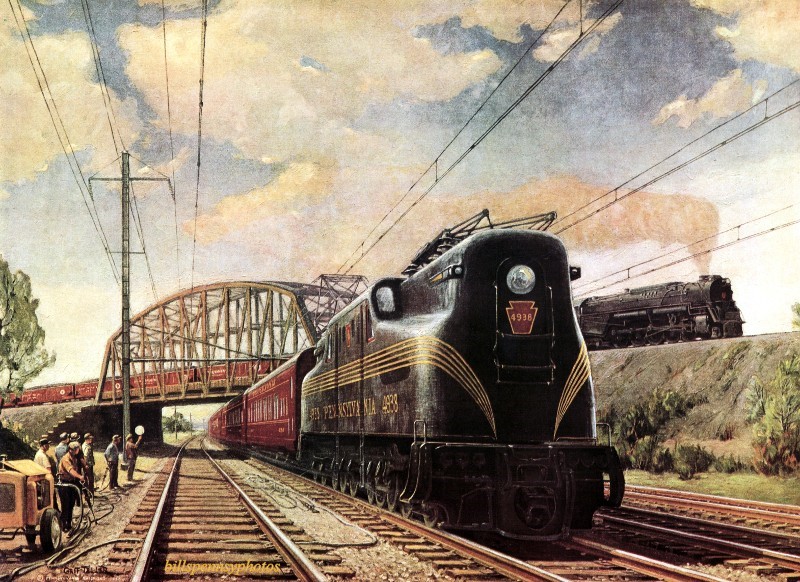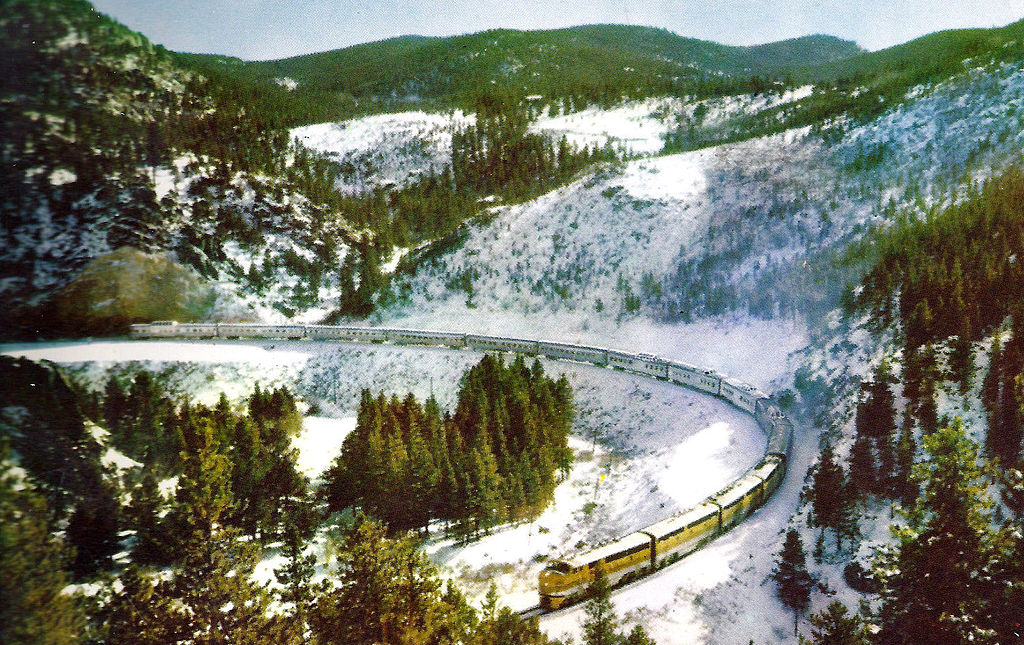Table of Contents
Quick Facts
| Year Founded | 1845 – As St. Paul & Pacific |
| Year of Demise | 1970 – Merged with NP, SP&S and CB&Q to form the Burlington Northern Railroad |
| Total Track Mileage | 11,000 |
| Number of States was Located In | 11 |
| Headquarters | Saint Paul, Minnesota |
History
The Great Northern Railway (reporting mark GN) was an American Class I railroad.
The railroad began life in 1845 as the St. Paul & Pacific Railroad. Founded by James Jerome Hill in St. Paul, Minnesota. The St. Paul & Pacific Railroad was chartered as a land grant of two million acres within the Minnesota, North Dakota and South Dakota area. The railroad was initially designed to move timber and minerals from Canada, along with wheat, Dakota sugar and Canadian flour.
By 1870, the St. Paul company started to acquire other railroads and expand its network, eventually connecting to the Northern Pacific Railway in Montana. With the acquisition, the line extended further west and was able to offer more services in the Midwest region. The St. Paul & Pacific Railroad was renamed the Great Northern Railway in 1889.
By 1900, it was the largest railway by land area in the United States.
During the years that followed, the Great Northern Railway expanded its network and service areas even further. The company purchased or consolidated numerous other independent rail companies, such as the Spokane & Northern Railway, the Chicago, Milwaukee & St. Paul Railway, and the Wisconsin Central Railway. With the consolidation of those companies and the completion of the Cascade Tunnel, the Great Northern Railway was able to offer service from Puget Sound to Chicago and from St. Paul to Portland in Oregon.
At its peak, the Great Northern Railway operated 11,000 miles of track and was one of the most successful railroads in the nation. The success of the Great Northern was largely due to its commitment to safety, dependability and courteous service—a driving force behind the slogan “The Empire Builder’s Line”. The railroad was also extensively used to transport commodities during WWII, as well as the post-war boom in passenger traffic.
By 1970, the Great Northern Railway saw a sharp decline in traffic due to competition from trucking companies, automobiles, and other railway carriers. As a result, the company merged with several other railroads including the Northern Pacific Railway, the Chicago, Burlington & Quincy Railroad, and the Spokane, Portland & Seattle Railway. These railroads formed the Burlington Northern in 1970.
Today, the Great Northern Railway lives on through the Burlington Northern Santa Fe, a US-based freight railway that continues to transport people and cargo across the United States. The legacy of the Great Northern Railway is marked by its commitment to efficiency, customer service, and growth—still keeping alive the spirit of the Empire Builder’s Line.
The Empire Builder Passenger Train
In 1929 that the Railway's flagship train, the Empire Builder, first appeared on the tracks. This comprehensive passenger service spanned over eight states, traversing from Chicago to Seattle. For over four decades, the Empire Builder embodied the grandeur of the American landscape while providing reliable transportation to over two million passengers a year.
Inspired by the American transcontinental railway, the Empire Builder differed from many of its contemporaries in its goal of providing interstates rail service. Its route began in Chicago, heading through Wisconsin and Minnesota as it ascended along the Mississippi River. Passing through South and North Dakota, Montana, and Idaho, the service traveled all the way to Spokane, Washington and finally to Seattle, Washington.
The Empire Builder's interior featured a variety of sleeper accommodations including cabins, dressing rooms and private compartments. All of these compartments featured amenities like comfortable beds, sofas, running water and toilets. The train was also closely connected to the surrounding world with daily newspapers, telegraph services and direct telephone connections from different train stations.
The Empire Builder did more than just provide a transport service; it embodied the spirit of exploration and discovery in a new frontier. Named in honor of James J. Hills, the ‘Empire Builder’ who transcended the Great Northern Railway into a national network and established new lines within the American landscape, the train symbolized the grandeur of a nation setting out to conquer new lands. The Empire Builder also served a more customary purpose, connecting communities and bringing renewed optimism to a populace struggling in the wake of the Great Depression.
Today, Amtrak’s Empire Builder train is still in service and continues to connect people to their destinations around the country. Although modern advancements and technology such as airplanes and consolidated railroad companies have changed the ways we view travel and transportation, the Empire Builder remains a cherished memory of the days when a train trip was a luxurious journey through some of the nation's most spectacular landscapes. Its legacy lives on today, connecting Americans to not just their desired destinations but also their past.
Surviving Steam Locomotives
| Locomotive | Type | Builder | Location |
| 1 | 4-4-0 | New Jersey Locomotive 1861 | Lake Superior Railroad Museum, Duluth, MN |
| 1147 | 2-8-0 | Rodgers 1902 | Stevens St Park, Wenatchee, WA |
| 1246 | 2-8-0 | Baldwin 1907 | Modoc Northern Siding, Merrill, OR |
| 1355 | 4-6-2 | Baldwin 1909 | Sioux City Railroad Museum, Sioux City, IA |
| 3059 | 2-8-2 | Baldwin 1913 | Railroad Park, Williston, ND |
| 2523 | 4-8-2 | Baldwin 1923 | Kandiyohi County Historic Park, Willmar, MN |
| 2507 | 4-8-2 | Baldwin 1923 | Wishram Amtrak Station, Wishram, WA |
| 2584 | 4-8-4 | Baldwin 1930 | Havre depot, Havre, MT |
| 2575 | 4-8-4 | Baldwin 1930 | Oregon Rail Heritage Center, Portland, OR |
Selected Surviving Diesel Locomotives
| Locomotive | Type | Builder | Location |
| 181 | NW3 | EMD 1942 | Whitefish Depot, Whitefish, MT |
| 192 | NW5 | EMD 1946 | North Shore Scenic Railroad Duluth, MN |
| 229 | RS-3 | EMD 1968 | Schenectady, NY |
| 400 | SD45 | EMD 1966 | Minnesota Transportation Museum, Jackson Street Roundhouse, St. Paul, MN |
| 454A | F7A | EMD 1950 | Prince George Railway and Forestry Museum, Prince George, B.C., Canada |

Riding the Line
[popup_anything id=”537″]
| Amtrak Train Name | Empire Builder |
| End Point Stations | Chicago, Seattle, Portland |
| Closest Airport to Chicago Union Station | Midway, 8.2 miles away |
| Closest Airport to Seattle Kings Street Station | Seattle Lake Union SPB Airport |
| Closest Airport to Portland Union Station | Portland International Airport |
| Number of hours of travel | 46 hours |
| Time train leaves Chicago | 3:05 PM Central Time |
| Time train leaves Seattle | 4:55 PM Pacific Time |
| Time train leaves Portland | 4:45 PM Pacific Time |
| Cost of a coach seat | $150.00 |
| Other services and upgrades available | Roomette Bedroom Bedroom Suite Family bedroom Accessible Bedroom Dining car |














